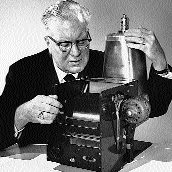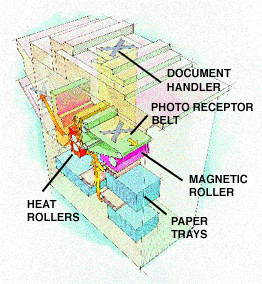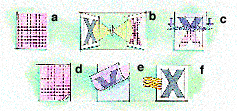by Chip Holt

INVENTOR CHESTER F. CARLSON re-creates the experiment
that marked the advent of xerography. The original machine never
worked well, but it provided the technological prototype for
today's photocopiers.
The term "xerography," the use of photoelectric
phenomena to transfer an image from one sheet of paper to another,
comes from the Greek words for "dry" and "writing." Chester
F. Carlson, a New York City patent attorney who had studied
chemistry at the California Institute of Technology, first demonstrated
this technique 58 years ago in a makeshift laboratory above
a bar in Astoria, Queens, N.Y.
Over the next six years, more than 20 companies
turned down Carlson's proposals to develop the technology. In
1944 Battelle Memorial Institute, a nonprofit research organization,
entered into a royalty-sharing arrangement with Carlson. Battelle
eventually signed a development contract in 1947 with Haloid
Company, a Rochester, N.Y., firm that produced photographic
paper and later became Xerox Corporation. The first xerographic
machine came onto the market in 1949, but it was slow, dirty
and hard to use. Not until 1959 did Xerox introduce an office
copier, the 914, which became the basis for the current multibillion-dollar
industry.

BIRTH OF XEROGRAPHY occurred on October 22,
1938, in Astoria, Queens, N.Y., when Carlson used the process
to print this notation on a glass slide using India ink.
CHIP HOLT is vice president of the Joseph C.
Wilson Center for Research and Technology at Xerox Corporation. |

Credit: Xerox Corporation; Barry Ross (drawings)
PHOTOCOPIER moves a document from the handler
to the glass platen (not shown), where the pattern of
the image is projected by lamps, mirrors and lenses onto a photoreceptor
belt (or drum). The electrostatic charge on the belt fades in
areas receiving light from the projected image. Magnetic rollers
brush the belt with dry ink (toner), which because of its static
charge clings to the image area on the belt. A sheet of copy
paper approaching the belt is also given a static charge sufficiently
strong to draw the image pattern in the toner away from the
belt. Rollers then apply heat and pressure to fuse the toner
image into place. For color copying, a multistep process is
used, which scans the image through color filters and then applies
separate toners for magenta, cyan, yellow and black.

Credit: Xerox Corporation; Barry Ross (drawings) DRY COPYING exploits the principles that materials
with opposite electrical charges attract one another and that
some materials conduct electricity better after exposure to
light. In the basic xerography process, a photoconductive surface
receives a positive electrical charge (a). An image is
then exposed on the surface; because the illuminated sections
(the nonimage areas) become more conductive, their charge dissipates
(b). Negatively charged powder spread over the surface
adheres through electrostatic attraction to the positively charged
image area (c). A piece of paper is then given a positive
charge (d) and placed over the surface, where it attracts
the negatively charged powder (e). Finally, heat fuses
the image as etched in powder to the paper (f).
|




